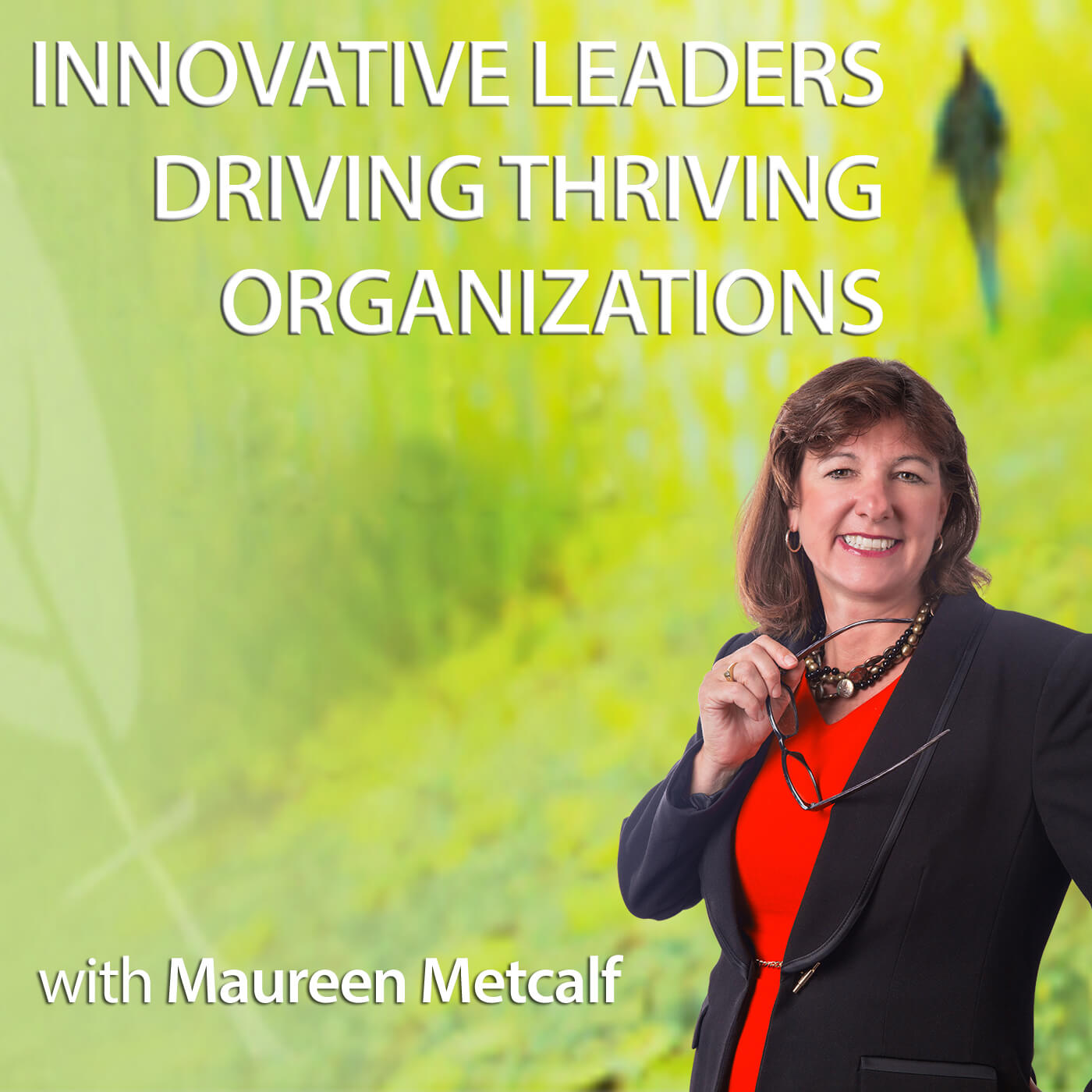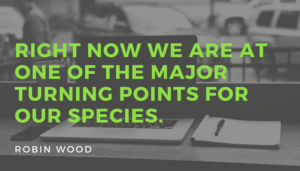This post is a companion to the Voice America show Synergise – Defining 21st Century Leaders with Maureen Metcalf & Dr. Robin Lincoln Wood. The post is written by Dr. Wood.
“As the twenty-first century unfolds, a new scientific conception is emerging. It is a unified view that integrates, for the first time, life’s biological, cognitive, social, and economic dimensions. At the forefront of contemporary science, the universe is no longer seen as a machine composed of elementary building blocks. We have discovered that the material world, ultimately, is a network of inseparable patterns of relationships; that the planet as a whole is a living, self-regulating system.
… Evolution is no longer seen as a competitive struggle for existence, but rather a cooperative dance in which creativity and constant emergence of novelty are the driving forces. And with the new emphasis on complexity, networks, and patterns of organisation, a new science of qualities is slowly emerging.”
Fritjof Capra and Pier Luigi Luisi
Right now we are at one of the major turning points for our species. The decisions we make going forward, especially in the next decade, will shape the future of homo sapiens and life on earth for many centuries, if not millennia, to come.
Our beautiful blue pearl of spaceship earth is host to 7.5 billion earthlings, in the midst of at least eight major transitions through Eras 2, 3 and 4, from agricultural through modern to regenerative civilisations. Our biggest challenge is neither technological nor scientific, but psychological, organisational and social.
How can 7.5 billion human beings be aligned in order to co-create thriveable futures, and ensure a viable biosphere for us all by 2050? We humans possess tremendous adaptive capacities, grounded in our having successfully transitioned through three major evolutionary eras.
We can build on our Era 1 ability to forge strong tribal bonds to ensure our local survival and thriving. These ethnocentric bonds and expressive talents are native to all of us, enabling us to take care of each other and the places we care for and hold sacred, while also exploring and connecting with nature and each other at a local level.
We can build on our Era 2 ability to manage cities, regions and nation states in more thriveable ways, respecting the rule of law and building intelligent infrastructures and systems fit for the future, based on enlightened entrepreneurship, conscious business sense and innovation. These civic-centric and enterprise-centric talents are increasingly evident around the world, from the developed nations to what were previously termed “developing countries”.
And we can build on our Era 3 ability to evolve our global systems embodied in our global treaties, corporations, markets and flows of people, goods, information and goodwill, so that our global systems also become a driver of a thriveable future for us all. These world-centric talents are now evident in nearly one billion global citizens, who are sufficiently educated and travelled that they can appreciate the glorious diversity of our species and other species.
As we enter Era 4, we now have the capacity to rapidly accelerate the evolution of our species, based on thriveable cultures, mindsets, principles and metrics. The forces and trends shaping our world and us are creating crises that demand a momentous leap from our previously lose-lose/win-lose “us versus them” mentality, to a co-creative, collaborative win/win/win approach.
This “triple win” is fundamental to aligning the interests and mindsets of all people on the planet, whatever kind of transition they are in and whatever their era: a win for each of us as individuals and for our communities, a win for the cities/towns/nations we live in, and a win for the planet as a whole. That is the whole point of synergistic innovation: co-creating triple wins.
There is much in this new approach that will appeal only to those who are willing to embrace complexity with a degree of openness to new perspectives that might at first appear surprising and counter-intuitive. Yet at the same time, there are several frameworks designed to provide simplified interfaces to topics that are devilishly complex for the uninitiated. In particular, the following frameworks are designed to enable you to remember and work with those elements of the book that are “psychoactive” i.e. designed to activate your own potentials and capacities for action to be an agent of thriveable evolution:
· The Four Eras Model – showcases the key aspects of the past 100 000 years of human evolution, to highlight the strengths and talents we have developed as a species to adapt and innovate. The core message from the way in which we have evolved and are still evolving, is that our socio-cultural ability to learn, communicate and innovate is the key to our survival, and our thriveability, enabling us to lock-in certain features of our world to the permanent benefit of us all. Put another way, we are who we are today because of the 10 000 major innovations that have locked in over the past 100 000 years, and which make it possible for you to even read and understand these words and then go and do something beneficial based on the fresh insights you have gained;
· The Eight Transitions Model – offers insights into the current state of the 7.5 billion humans on our planet through the lens of the eight transitions our species is currently experiencing. Some of those transitions are simply linear progressions from one Era to another, while some transitions involve a leapfrogging from Era 2 to Era 4 or Era 1 to Era 3. All of these transitions can be made more thriveable through the application of appropriate methods and technologies, including socio-cultural and mindset shifting approaches;
· The Eight Capitals Model – explores the eight essential ingredients that need to be regenerated in order to have an abundant and thriving future for all life on earth. The mix of these ingredients will vary depending upon the life conditions and culture being experienced in the system-in-focus, and the nature of the socio-technical systems being applied. A way of measuring the potential for ThriveAbility in any human system at any scale is explained in the ThriveAbility Equation, providing a means by which the outcomes of different options and innovations can be measured, integrated into a single outcome variable known as “True Future Value”;
· The Six Pathways Model – maps the journey from our current degenerative, exclusive societies to a regenerative, inclusive world are illustrated with dozens of examples, known as “pockets of the future in the present”. The pathways are based on the eight capitals integrated with the natural evolutionary paths of the current major industries that power our planet and our lifestyles today. Some innovations are simply incremental extensions of current technologies; products and practices confined to a single pathway. The most powerful synergistic innovations manage to combine elements of all six pathways, leading to breakthroughs that make the impossible possible;
· The Six Ingredients of Synergistic Innovation Model – applying the “Six C’s” model to any human activity system we are engaged with provides a powerful framework that enables any participant/observer to identify synergy zones and opportunities, as well as zones of compromise and conflict. The goal of any thriveable systems designer is to help the system they are focusing on, to go into healthy “upstretch” mode rather than shifting back down to a “downshift”.
Despite an increasingly volatile and uncertain world, we can take comfort in the fact that, despite the chaotic, hyper-complex life conditions we are currently experiencing in our various transitions into Era 4, evolution is unfolding as it should. The trajectory of evolution is, in the end, toward a global synthesis of all forms of life in a harmonious whole.
Evolution is Driven by the Synergies of Diversification and Integration Creating More
Complex and Conscious Wholes
As Daniel Wahl puts it:[ii]
“Modern evolutionary biology suggests that life evolves by a process of diversification and subsequent integration of diversity through collaboration. As the focus shifts from individuals and individual species as the unit of survival to the collective of life — its complex dynamic interactions and relationships — we begin to see that collaborative and symbiotic patterns and interactions are of more fundamental importance than competition as a driving force of evolution. Life’s key strategy to create conditions conducive to life is to optimize the system as a whole rather than maximizes only some parameters of the system for a few at the detriment of many.”
For those of us who seek to activate thriveable shifts in the people and systems we engage with on a daily basis, knowing this offers us a special reward – the knowledge that our lives have a purpose and meaning much higher than ourselves, and that we are called to be stewards of the greatest shift, the most momentous leap that humankind has ever made. I will leave you with these final eloquent words of Michelle Holliday to reflect upon as you being your own journey down this glorious path”
“The call of stewardship guides us toward continuous generativity – toward cultivating fertile ground and manifesting new possibilities for the future. To enable the system to take on a life of its own and to help it become truly, gloriously generative, the challenge of stewardship is to navigate a thoughtful mix of control, guidance and nurturing; to tend to both individual and collective; and to support the system’s wisdom, learning and enrichment, as well as its accomplishment of tasks and milestones.






